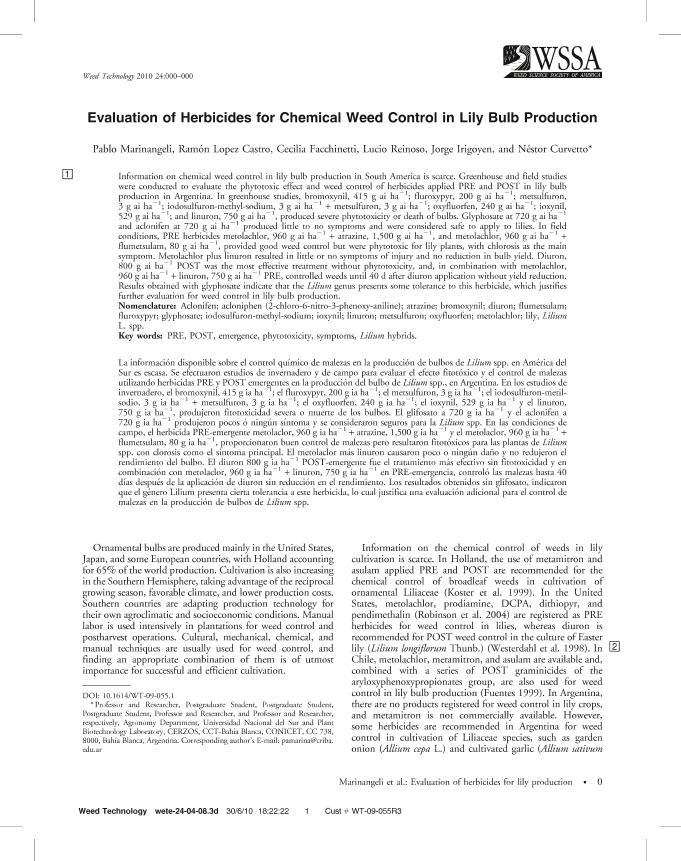Artículo
Evaluation of herbicides for chemical weed control in lily bulb production
Marinangeli, Pablo Alejandro ; López Castro, Ramón Ignacio
; López Castro, Ramón Ignacio ; Facchinetti, Cecilia
; Facchinetti, Cecilia ; Reinoso, Lucio Gabriel; Irigoyen, Jorge Horacio; Curvetto, Nestor Raul
; Reinoso, Lucio Gabriel; Irigoyen, Jorge Horacio; Curvetto, Nestor Raul
 ; López Castro, Ramón Ignacio
; López Castro, Ramón Ignacio ; Facchinetti, Cecilia
; Facchinetti, Cecilia ; Reinoso, Lucio Gabriel; Irigoyen, Jorge Horacio; Curvetto, Nestor Raul
; Reinoso, Lucio Gabriel; Irigoyen, Jorge Horacio; Curvetto, Nestor Raul
Fecha de publicación:
12/2010
Editorial:
Weed Science Society of America
Revista:
Weed Technology
ISSN:
0890-037X
e-ISSN:
1550-2740
Idioma:
Inglés
Tipo de recurso:
Artículo publicado
Clasificación temática:
Resumen
Information on chemical weed control in lily bulb production in South America is scarce. Greenhouse and field studies were conducted to evaluate the phytotoxic effect and weed control of herbicides applied PRE and POST in lily bulb production in Argentina. In greenhouse studies, bromoxynil, 415 g ai ha-1; fluroxypyr, 200 g ai ha-1; metsulfuron, 3 g ai ha-1; iodosulfuron-methyl-sodium, 3 g ai ha-1 metsulfuron, 3 g ai ha-1; oxyfluorfen, 240 g ai ha-1; ioxynil, 529 g ai ha-1; and linuron, 750 g ai ha-1, produced severe phytotoxicity or death of bulbs. Glyphosate at 720 g ai ha-1 and aclonifen at 720 g ai ha-1 produced little to no symptoms and were considered safe to apply to lilies. In field conditions, PRE herbicides metolachlor, 960 g ai ha-1 atrazine, 1,500 g ai ha-1, and metolachlor, 960 g ai ha-1 flumetsulam, 80 g ai ha-1, provided good weed control but were phytotoxic for lily plants, with chlorosis as the main symptom. Metolachlor plus linuron resulted in little or no symptoms of injury and no reduction in bulb yield. Diuron, 800 g ai ha-1 POST was the most effective treatment without phytotoxicity, and, in combination with metolachlor, 960 g ai ha-1 linuron, 750 g ai ha-1 PRE, controlled weeds until 40 d after diuron application without yield reduction. Results obtained with glyphosate indicate that the Lilium genus presents some tolerance to this herbicide, which justifies further evaluation for weed control in lily bulb production.
Palabras clave:
EMERGENCE
,
LILIUM HYBRIDS
,
PHYTOTOXICITY
,
POST
,
PRE
,
SYMPTOMS
Archivos asociados
Licencia
Identificadores
Colecciones
Articulos(CERZOS)
Articulos de CENTRO REC.NAT.RENOVABLES DE ZONA SEMIARIDA(I)
Articulos de CENTRO REC.NAT.RENOVABLES DE ZONA SEMIARIDA(I)
Citación
Marinangeli, Pablo Alejandro; López Castro, Ramón Ignacio; Facchinetti, Cecilia; Reinoso, Lucio Gabriel; Irigoyen, Jorge Horacio; et al.; Evaluation of herbicides for chemical weed control in lily bulb production; Weed Science Society of America; Weed Technology; 24; 4; 12-2010; 483-488
Compartir
Altmétricas



